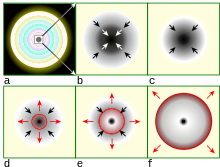
Back انهيار تثاقلي Arabic Гравітацыйны калапс Byelorussian Гравітацыйны каляпс BE-X-OLD Гравитационен колапс Bulgarian মহাকর্ষীয় পতন Bengali/Bangla Col·lapse gravitatori Catalan Gravitační kolaps Czech Gravitationskollaps German Βαρυτική κατάρρευση Greek Gravita kolapso Esperanto
This article needs additional citations for verification. (October 2009) |

Gravitational collapse is the contraction of an astronomical object due to the influence of its own gravity, which tends to draw matter inward toward the center of gravity.[1] Gravitational collapse is a fundamental mechanism for structure formation in the universe. Over time an initial, relatively smooth distribution of matter, after sufficient accretion, may collapse to form pockets of higher density, such as stars or black holes.
As a clandestine form of gravitational collapse, the gradual gravitational collapse of interstellar medium into clumps of molecular clouds and potential protostars, is the birth of a star. The compression caused by the collapse raises the temperature until thermonuclear fusion occurs at the center of the star, at which point the collapse gradually comes to a halt as the outward thermal pressure balances the gravitational forces. The star then exists in a state of dynamic equilibrium. During the star's evolution a star might collapse again and reach several new states of equilibrium.
- ^ Pilchin, Lev Eppelbaum, Izzy Kutasov, Arkady (2013). Applied geothermics (Aufl. 2014 ed.). Berlin, Heidelberg: Springer Berlin Heidelberg. p. 2. ISBN 9783642340239.
{{cite book}}: CS1 maint: multiple names: authors list (link)
© MMXXIII Rich X Search. We shall prevail. All rights reserved. Rich X Search